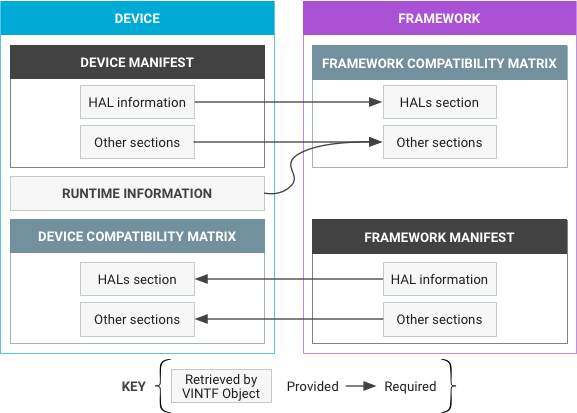Tài liệu này mô tả thiết kế của đối tượng giao diện nhà cung cấp (đối tượng VINTF). Đối tượng này tổng hợp thông tin liên quan về một thiết bị và cung cấp thông tin đó thông qua một API có thể truy vấn.
Thiết kế đối tượng VINTF
Đối tượng VINTF thu thập một số thông tin cần thiết trực tiếp từ thiết bị. Các khía cạnh khác, chẳng hạn như tệp kê khai, được mô tả tĩnh trong XML.

Hình 1. Tệp kê khai, ma trận khả năng tương thích và thông tin có thể thu thập trong thời gian chạy.
Thiết kế đối tượng VINTF cung cấp những thông tin sau cho các thành phần thiết bị và khung:
| Đối với thiết bị | Đối với Khung |
|---|---|
|
|
Đối tượng VINTF phải đáng tin cậy và cung cấp cùng một thông tin đầy đủ bất kể thời điểm yêu cầu đối tượng (xem Thận trọng).
Tệp kê khai và ma trận
Kể từ Android 8.0, API thời gian chạy sẽ truy vấn nội dung trên thiết bị và gửi thông tin đó đến máy chủ cập nhật qua mạng không dây (OTA) và các bên quan tâm khác (chẳng hạn như CTS DeviceInfo). Một số thông tin được truy xuất trong thời gian chạy và một số thông tin được xác định tĩnh.
- Tệp kê khai thiết bị mô tả thành phần tĩnh của những gì thiết bị có thể cung cấp cho khung.
- Ma trận tương thích khung mô tả những gì khung Android mong đợi từ một thiết bị nhất định. Ma trận là một thực thể tĩnh, có thành phần được xác định theo cách thủ công trong quá trình phát triển bản phát hành tiếp theo của khung Android.
- Tệp kê khai khung mô tả các dịch vụ cấp cao mà khung có thể cung cấp cho thiết bị.
- Ma trận khả năng tương thích của thiết bị mô tả các dịch vụ mà hình ảnh nhà cung cấp yêu cầu đối với khung. Thành phần của nó được xác định theo cách thủ công trong quá trình phát triển thiết bị.
Hai cặp tệp kê khai và ma trận này phải được điều chỉnh cho phù hợp tại thời điểm OTA để đảm bảo thiết bị có thể nhận được các bản cập nhật khung tương thích với chức năng của thiết bị. Nhìn chung, tệp kê khai mô tả nội dung được cung cấp và ma trận khả năng tương thích mô tả nội dung bắt buộc.
Phần này bao gồm các thông tin chi tiết sau đây về tệp kê khai và ma trận:
- Tệp kê khai xác định tệp kê khai thiết bị, tệp kê khai khung và giản đồ tệp kê khai.
- Ma trận tương thích xác định giản đồ cho ma trận tương thích.
- Vòng đời FCM trình bày chi tiết cách các HAL HIDL không còn được dùng nữa và bị xoá, cũng như cách các tệp FCM được sửa đổi để phản ánh trạng thái của Phiên bản HAL.
- Phát triển DM mô tả cách nhà cung cấp có thể xác định và khai báo Phiên bản FCM mục tiêu trong tệp kê khai thiết bị cho thiết bị mới hoặc triển khai các phiên bản HAL mới và tăng Phiên bản FCM mục tiêu khi nâng cấp hình ảnh nhà cung cấp cho thiết bị cũ.
- Quy tắc so khớp xác định các quy tắc để so khớp thành công giữa một ma trận khả năng tương thích và một tệp kê khai.

